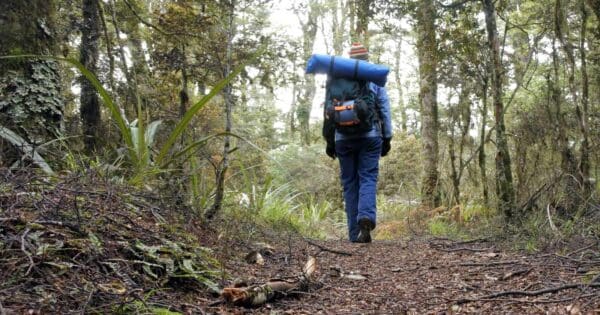What is a Personal Locator Beacon (PLB)?
A personal locator beacon (PLB) is a small, handheld device that can be used to transmit a distress signal to a satellite system. PLBs are used to alert search and rescue authorities in the event of an emergency.
Why should hikers in Australia carry a PLB?
Australia is a vast and remote country, and many hiking trails are located in areas with limited or no cell phone service. If you get lost or injured while hiking in Australia, a PLB can be your lifeline. It’s my recommendation that every person carry a PLB. I’ve seen people recommend one per group but what happens if the group member who has the PLB becomes isolated from the group or is the one who’s fallen and other group members can’t access them to activate the PLB? Whether you are hiking solo, with another person, or with a group, it’s important everyone is self-reliant. This relates to pre-trip planning and on-trail safety.
Here are some examples of situations where a PLB can save your life:
- You get lost on a hiking trail and cannot find your way back.
- You are injured while hiking and cannot move on your own.
- You are trapped in a cave or other remote location.
- Your vehicle breaks down in a remote area and you have no cell phone service.
- You are involved in a boating accident.

What happens after you activate a PLB?
When a PLB is activated, it transmits a distress signal to the Cospas-Sarsat satellite system. Cospas-Sarsat is a global satellite network that is dedicated to detecting and responding to distress signals from emergency beacons. The Cospas-Sarsat system can detect PLB signals from anywhere in the world, regardless of weather conditions. Once Cospas-Sarsat has received a distress signal from a PLB, it relays the signal to the nearest rescue coordination center (RCC).
Here’s a brief overview of what happens next:
- Distress beacon is activated: When your life is in danger and you can’t get hold of emergency services by phone or radio, activate your distress beacon. Your beacon can be activated from anywhere on the Earth’s surface, regardless of whether you were travelling by air, land or sea.
- Signal is received by satellite: The international search and rescue satellite system, Cospas-Sarsat, listens from space for distress signals. When it hears a signal, it notifies the nearest ground station. Beacons transmit on 406MHz which is detectable by satellite and 121.5MHz so emergency services can hone the beacon with special search and rescue equipment.
- Rescue coordination centre is notified: Your distress call is escalated through a local user terminal, mission control centre and then the rescue coordination centre (RCC) responsible in that region for arranging search operations. If your beacon is registered, the details are provided to the RCC in the country in which the beacon is both activated and registered.
- Search and rescue operations commence: Search and rescue authorities commence search operations as soon as they can. If your beacon is registered, AMSA Search and Rescue will look up your account and ring your emergency contacts immediately. If emergency contacts are aware of trip details or trip details have been submitted online, search operations can be commenced much sooner. So it is essential to keep your details up to date.
The time it takes for rescue will vary depending on the circumstances. Be prepared to survive. When you see or hear search personnel or aircraft in your area use flares, torches, or light a fire (if it’s safe) to help them pinpoint your location.
How long does it take to be rescued?
The time it takes for search and rescue personnel to reach you depends on a number of factors, including the weather, terrain and accessibility of your location. The more remote the location of the distress incident, the longer the response time. In all instances, be prepared to survive.
Satellites cannot detect beacons through mountains, trees or buildings. If your beacon has not been deployed correctly with the aerial vertical in a clear open area or you are located in a valley, geostationary (GEO) satellites are unlikely to see you. In these cases, you must wait for polar-orbiting (LEO) satellites to pass overhead, which may take several hours. Another important factor which determines how long your rescue takes is if you have a Global Positioning System (GPS) beacon or a non-GPS beacon.
What should you do after activating your PLB?
Once you have activated your PLB, there are a few things you should do:
- Stay calm and wait for help to arrive.
- Try to conserve your energy
- It can take time for rescuers to reach you, so your priority is to find (or build) shelter to keep warm and dry.
- Find a water source if it’s safe to do so and ration your food and water if necessary until help arrives.
- Remember to remain visible. If possible, mark your location with something visible, such as a piece of brightly colored cloth and be prepared to signal for help.
- If you have a satellite phone or other communication device, try to contact the RCC directly.

Increasing your chances of being rescued
- Register your PLB with the Australian Maritime Safety Authority (AMSA). This will allow AMSA to contact your emergency contacts in the event of a PLB activation.
- Test your PLB regularly to make sure it is working properly.
- When activating your PLB, keep it in a clear area with a good view of the sky.
- Stay with your PLB and minimise your movements until rescuers arrive.
- Always tell someone where you are going and when you expect to be back.
- Plan your hikes carefully and make sure you have the proper gear and supplies.
- Be aware of the weather conditions and be prepared for changes.
- Hike with a buddy or group whenever possible.
- If you do get lost or injured, stay calm, stay still and activate your PLB as soon as possible.
Accidental activation
If your beacon is accidentally activated, switch it off immediately and contact the Australian Maritime Safety Authority (AMSA) on 1800 641 792. There is no penalty for accidental activation.
Using Australian PLBs overseas
Beacons are detected world-wide by the global satellite system, Cospas-Sarsat, and are detected from anywhere on the Earth’s surface if they are deployed correctly.
Please note that it is illegal in some countries to carry or activate a Personal Locator Beacon (PLB) on land. Refer to the Cospas-Sarsat website for the appropriate SPOC (search and rescue or SAR point of contact) for the country you are travelling to and contact them to confirm you are legally allowed to use your beacon. You may also refer to the National Regulations for the Use of PLBs.
Search and rescue response in each country will vary due to different levels of SAR resources and capability. Check locally about the sort of SAR response you can expect. The response will also depend on the weather conditions at the time e.g. day, night, visibility (low cloud, fog, snow), high winds etc.
The rescue coordination centre of the country where the beacon is detected will coordinate the search and rescue response, not Australia. AMSA’s Response Centre will only provide the registration details, if known, and any other information it gathers from emergency contacts. AMSA will request information on the progress of the search and rescue.
Contact your chosen airline for guidance on carrying distress beacons as every airline and airport have differing requirements.
Using international PLBs in Australia
Internationally purchased beacons can be activated in Australia and Australia will coordinate the search and rescue response. However, your beacon needs to be coded and registered to your country of residence.
PLBs are a valuable safety tool for hikers in Australia. If you are planning a hike, be sure to carry a PLB and register it with AMSA. By following the tips above, you can increase your chances of being rescued if you ever need to use your PLB.
For more information, visit the AMSA website. For tips on keeping your beacon in perfect working order, click here.





It’s also my recommendation that every person carry a PLB. I’ve seen people recommend one per group but what happens if the group member who has the PLB becomes isolated from the group or is the one who’s fallen and other group members can’t access them to activate the PLB?
Whether you are hiking solo, with another person, or with a group, it’s important everyone is self-reliant. This relates to pre-trip planning and on-trail safety.
Great information here as usual. Especially since not many will know about. 👏👏👏
Ummm, have you ever been in this situation?
“The RCC will use the information transmitted by your PLB to determine the nature of the emergency and your approximate location.”
Curious how the PLB can transmit the nature of the emergency? All it sends is the location.
“as well as any other information they can gather, such as cell phone signals or credit card transactions.”
Are you sure? How would they even know my credit card number? I think you really needed to talk to someone who had been in this situation before writing this article.
In fact, the first thing they do, in NSW anyway, is to verify that the alarm is genuine before dispatching any rescue teams. This means firstly ringing the owner’s number from the AMSA database, then the emergency contacts to verify you are in the area the alarm went off. So you need to make sure your emergency contacts know what you are doing and where you are.
Then they will drive, in one case, 40km from the police station out into the bush to verify that there is still a car at the trackhead. People sometimes set off the PLB, then manage to get themselves out, but do not bother to cancel the alarm.
Once satisfied, they will usually send out a ground team or a light plane or police helicopter to locate the PLB and identify the nature of the emergency. (This is because helicopters are expensive, and have to be paid for.) In one case, the policeman dropped down, only to find it was a serious injury, said “we cannot deal with this”, and went back up to his helicopter to call the rescue helicopter. (The police helicopter is cheaper to call out than a rescue helicopter.)
So then the rescue helicopter will arrive and drop a paramedic down. If it is near dark – and it often is because it can be many hours since the PLB had been set off – they will make people comfortable overnight and extract the injured or lost person the next day.
A few tips:
DO NOT have a fire going when helicopters are overhead. The fire will be blown everywhere and burns or a bushfire could result.
Be alert if a helicopter is overhead in forest. The downdraft can break big branches off trees which spear into the ground or anyone underneath.
David F Morrison fortunately I’ve never needed to activate mine. Thanks for pointing out the couple of errors. I accidentally left them in from another post I was writing. I’ve fixed that section now. Cheers.
On a solo sea-kayak trip across Bass Strait, my PLB stopped working (when tested). Manufacturer later replaced it, stating my damaged unit had a hairline crack in it.
I paddled on to Hogan Island, then days later, direct to the Victorian village of Port Welshpool.